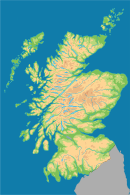Gartlea Farm Conservation Plan
Contact details: Janet Beveridge
gartlea@btinternet.com

Location
What are the aims of your project?
Gartlea is embarking on a plan designed to improve the viability of the Farm, with an objective to integrate and expand the environmental, economic and socially sustainable elements based on the natural resources of the land to contribute to the Scottish Government’s aim and targets for climate change and increasing sustainability. I have a keen interest in environmental issues and our farm has lots of natural open habitat that we can manage to make it more attractive for wildlife, like butterflies and waders. The AECS project funding will provide us with the opportunity to do additional things such as control diffuse pollution by fencing off our livestock from water margins and also to improve our peatland too.
How did your project achieve these aims?
The management options have been selected to offer the best opportunities to enhance wildlife habitats, improve and diversify landscape, as well as the objective of addressing the diffuse pollution issues.
What were the range of actions undertaken to achieve the project?
Wader grazed grassland - 32Ha are managed to protect ground nesting birds and fledglings and other wildlife through appropriate levels at different times of year, rush management and creation of wader scrapes.
Habitat mosaic management - 43Ha are managed for biodiversity benefits from as range of natural habitats (raised bog, ponds, species rich grassland) for a variety of species such as butterfly orchids, Grass of Parnasus, Yellow rattle, white beaked sedge as well as several butterflies, namely Ringlet, Small Blues, Small Coppers, Green Hairstreak and Small pearl bordered Fritillary
Moorland management- 76Ha are managed to improve the quality of moorland habitats through appropriate levels of grazing with Luing cattle. Some peat dams have also been created to slow the flow of water from the moorland. Fencing will also be used to control cattle access to a scheduled ancient monument, a Neolithic cairn.
Water margins - will be subject to controlled grazing
Extended hedgerows - will be cut on a three years rotation to provide wildlife corridors linking different areas of the farm.
Who’s involved?
The farmer, Janet Beveridge, is responsible for delivering the project.
How was the project funded?
The project is funded by the Agri-Environment Climate Scheme and the farmer.
Where did you go for help and advice?
This has been obtained from various sources not least Kevin Stewart of Laurence Gould Partnership and many years experience of environmental management by the farmer.
What has been your greatest achievement so far?
The project is in the first year of a five-year plan so very early days so far. The aim is to integrate practical farm management with the diverse range of habitats that are found on the farm.
And the biggest challenge?
The biggest challenge will be achieving the correct balance of grazing through all the variety of rainfall the Scottish weather has in store. Not damaging fragile habitat through excessive trampling by cattle in wet weather will be a challenge.
Any tips for those setting up a similar project?
The scheme is very complicated and requires a great deal of paperwork. This may well limit the appeal to the less dedicated conservationists. It's very important that schemes such as AECS are available for farmers to help manage their habitat. Otherwise without schemes like these, the amount of semi natural habitat on farm will continue to diminish. A variety of habitats require sympathetic management not just woodland which tends to be where the emphasis is usually placed. I would encourage other farmers to think about the habitat on their farm and to apply for the AECS scheme this year, to help them make some changes that could benefit both them and the environment.
- Log in to post comments